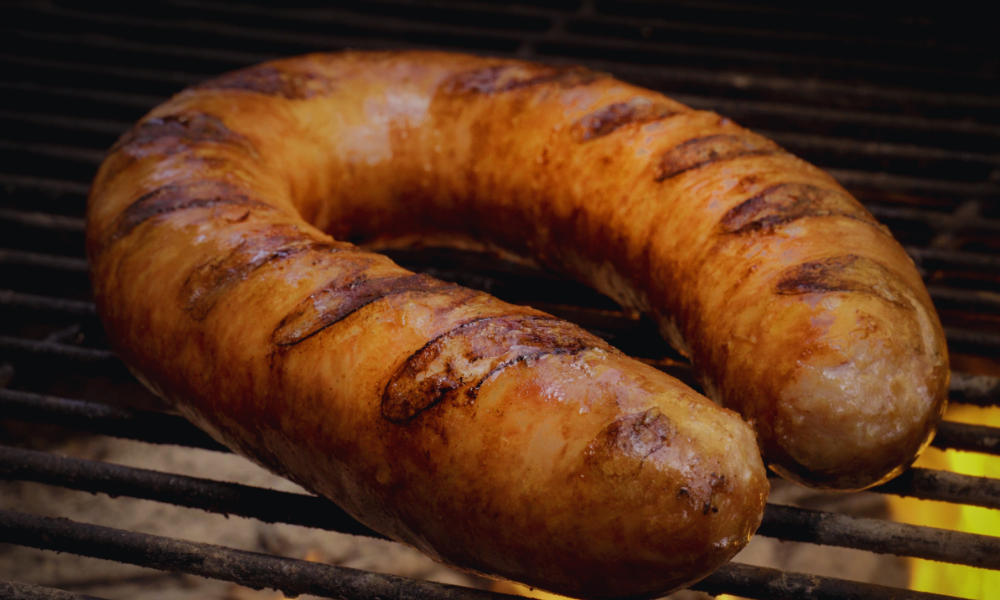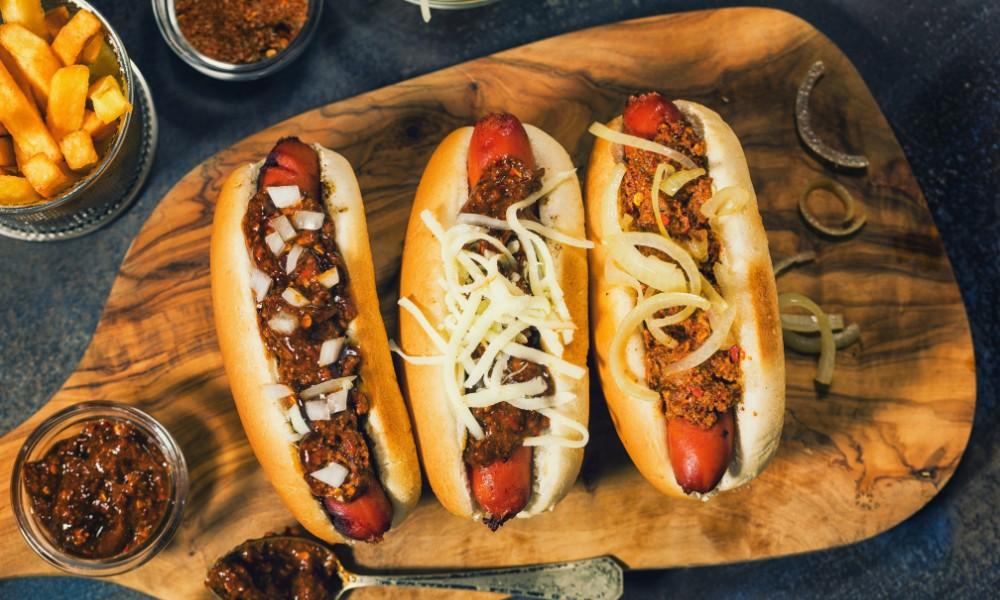Discover the distinct flavors and textures of Polish dogs vs hot dogs: smokier, robust Polish sausages with kielbasa, vs milder, smoother hot dogs. Learn their unique preparation styles and regional variations to elevate your next meal or gathering. 🌭🍴
📝 Note: Both are high in fat and sodium, indulge wisely!
Polish Dog vs Hot Dog Comparison Table
| Aspect | Polish Dog | Hot Dog |
|---|---|---|
| Origin | Coarse ground beef or a blend | Fine ground beef, pork, or a mix |
| Texture | More robust | Smoother consistency |
| Flavor | Smoky, more garlic | Milder, often saltier |
| Nutrition | Higher in calories, larger serving size | Slightly lower in calories, smaller serving size |
| Cooking Method | Boiling: Tender texture Grilling: Crispy exterior | Boiling: Even cook Grilling: Charred taste |
| Regional Variations | New York: Sauerkraut, spicy brown mustard | Chicago: Relish, onion, tomato, pickle, poppy seed bun |
| Serving Suggestions | Traditional: Sauerkraut, potatoes Modern: Polish dog tacos | Traditional: Onions, peppers, sour cream Modern: Craft mustard, fresh herbs |
| Global Variations | Japan: Seaweed, teriyaki sauce | Brazil: Corn, potato sticks, cheese |
| Modern Trends | Artisanal: Gourmet toppings, craft sausages | Sustainability: Locally sourced, organic options |
The Origins and Cultural Significance

Historical Background of the Hot Dog 🌭
The hot dog as we know it today originated from German and Austrian immigrants who brought their recipes for Frankfurter Würstchen and Wiener Würstchen to America. These sausages, served in a split bun, became a staple of street carts in major cities like New York and Chicago, symbolizing the melting pot of American culture. Their popularity soared, making them an integral part of national identity, especially intertwined with baseball and Independence Day celebrations.
Origins of the Polish Dog and Its Cultural Significance

On the other hand, the Polish dog, or Kielbasa as it’s known in Poland, boasts a rich history of its own. A cornerstone of Polish cuisine, kielbasa comes in various forms, but it’s the smoked variety that’s most frequently associated with the Americanized Polish dog. Kielbasa was brought to the United States by Polish immigrants, and like the hot dog, it quickly became a fixture in areas with a large Polish population. Its cultural significance lies not only in its traditional recipes but also in its presence at cultural events and family gatherings, symbolizing comfort and community.
Ingredient Analysis 🧐
When it comes to dissecting the makeup of these two sausages, the devil is in the details, and my time at the Boat Basin Cafe has taught me that quality ingredients are what truly set apart a good sausage from an unforgettable one. Let’s delve into the meats, spices, and unique components that define both the Polish dog and the hot dog.
Types of Meat Used in Both
Traditionally, hot dogs are made from a mélange of beef, pork, or a mix of both, ground to a fine texture. The meats are selected for their ability to create a smooth, almost emulsified consistency, ensuring a delicate bite each time.
On the other side of the ring, Polish dogs often use coarser ground meat, usually beef or a combination of beef and pork, which gives them a heartier texture that’s a bit more rustic than their hot dog counterparts.
| Polish Dog | Hot Dog |
|---|---|
| Coarse ground beef or a blend | Fine ground beef, pork, or a mix |
| More robust texture | Smoother consistency |
🧂 Seasoning and Flavor Profile Differences
While both sausages include a base of garlic, salt, and other spices, Polish sausages have a distinctly smokey taste that is missing in hot dogs, imparting a boldness that can stand up to other strong flavors when served with accompaniments. This smokiness is often complemented with a more generous use of garlic and sometimes marjoram or other regional herbs, which together produce the unique smoky flavor that is signature to Polish dogs.
| Polish Dog | Hot Dog |
|---|---|
| Smoky flavor, more garlic | Milder, often saltier taste |
Unique Ingredients in Polish Dogs Not Found in Traditional Hot Dogs
Notably, the Polish sausage might also contain a smidgen of sugar, giving it a subtle sweet undertone to balance the smokiness. In my time preparing and serving food at the Boat Basin Cafe, I learned that it’s often these small twists that elevate a dish from everyday to extraordinary.
👨🔬 Nutritional Comparison
When it comes to savoring a Polish dog or a classic hot dog, knowing the nutritional content is as important as enjoying the taste. It’s wise to understand what each sausage brings to the table—beyond their flavors—so you can make informed choices about your diet.
Breaking Down the Calories and Macronutrients
Let’s shed some light on the average caloric and macronutrient breakdown of these tasty treats. While individual products may vary, here is a general guide to what you can expect in a typical serving:
Nutritional Content Comparison (for the meat only)
| Nutrient | Polish Dog (per serving) | Hot Dog (per serving) |
|---|---|---|
| Calories | 280-330 | 150-180 |
| Total Fat | 24-29g | 13-16g |
| Saturated Fat | 9-11g | 5-6g |
| Cholesterol | 60-70mg | 30-35mg |
| Protein | 11-14g | 5-7g |
| Sodium | 990-1250mg | 450-550mg |
| Carbohydrates | 2-4g | 2-3g |
As seen in the table, Polish dogs typically have more calories and a higher fat content than hot dogs. This is largely attributed to their larger size and the specific cuts of meat used. The protein content in Polish dogs is also higher, which is something to consider if you’re looking to increase your protein intake.
Additional Components: Breads, Sauces, and Toppings
When enjoying a hot dog or a Polish dog, various breads, sauces, and toppings can significantly impact the overall nutritional content. Below is the general nutritional information for these common additions for one serving to go along with your sausage:
| Component | Calories | Total Fat (g) | Sodium (mg) | Carbohydrates (g) |
|---|---|---|---|---|
| Hot Dog Bun | 120-150 | 2-3 | 200-250 | 20-25 |
| Ketchup | 15-20 | 0 | 150-170 | 3-5 |
| Mustard | 10-15 | 0-1 | 100-120 | 0-1 |
| Relish | 15-20 | 0 | 120-150 | 3-5 |
| Onions (chopped) | 10-15 | 0 | 0-5 | 2-3 |
A basic hot dog with a bun and condiments can easily double in calorie content compared to the sausage alone. The addition of toppings like ketchup, mustard, and relish also increases the total sodium and carbohydrate intake. However, these additions can enhance the flavor and enjoyment of the meal. It’s important to consider these factors when indulging in these popular snacks, especially if you’re mindful of your overall dietary intake.
🧪 Understanding the Vitamins and Minerals
In addition to the macronutrients, both types of sausages contain various vitamins and minerals, like B vitamins crucial for energy metabolism, and iron, which is important for blood health. However, because these are processed meats, they should not be your primary source of such nutrients.
⚠️ Health Considerations: Balancing Indulgence and Nutrition
While both sausages contain substantial sodium levels, which might be a concern for those monitoring their salt intake, Polish dogs generally contain more due to their size and seasoning. Saturated fat is another aspect where Polish dogs rank higher, which can impact heart health if consumed in excess.
But it’s not all cautionary; both hot dogs and Polish dogs can fit into a balanced meal plan. Pairing them with healthier options like whole grain buns, fresh vegetable toppings, or side salads can add nutritional value and enhance the overall meal. 🥗
📌 Remember, the key to enjoying these foods lies in moderation and thoughtful pairing. With this detailed nutritional understanding, you’re more equipped to make choices that suit both your palate and your health. Enjoy your Polish dog or hot dog at your next BBQ, but keep these numbers in mind when you do. 😎
💡 Preparation and Cooking Techniques
How you cook a sausage can be just as important as the ingredients you use. Ask any chef, and they’ll tell you that technique is where the culinary arts truly shine. Whether you favor the bold flavors of a Polish dog or the classic American hot dog, mastering the cooking method is key to unlocking the best experience for your taste buds.
✅ The Right Way to Cook Hot Dogs: Chefs’ Tips and Tricks 👨🍳

Hot dogs are famously versatile when it comes to cooking. “The beauty of a hot dog lies in its simplicity. But don’t be fooled—simple doesn’t mean careless. Whether you’re boiling, steaming, or grilling, each method should be executed with attention,” says James Peterson, award-winning cookbook author and culinary teacher. Boiling is swift and easy, ensuring a juicy bite, while grilling brings out a delightful snap and a smoky char that can elevate a simple hot dog to an artisanal level.
“Every method subtly alters the dog’s flavor profile, so it’s all about personal preference and the joy of experimentation,” explains Peterson.
| Cooking Technique | Expert Tip |
|---|---|
| Boiling | Swift and ensures juiciness |
| Grilling | Provides a smoky char and enhances the snap |
Mastery Over Polish Dogs: The Art of Low and Slow

When it comes to Polish dogs, the process often involves more than just heat—it’s about infusing the meat with robust flavors. Low and slow grilling allows the smoke to deeply infuse the flavor. As the one and only Adam Perry Lang puts it:
“Polish dogs are heartier with a dominant smoky taste. The key is low and slow grilling to let the smoke do its magic without overpowering the meat’s natural flavors.”
Adam Perry Lang, renowned chef and grill master
How Cooking Influences Texture and Flavor: Culinary Experts Chime In

Notably, it’s not just about the taste but also the texture. Developing a perfect crust through grilling or getting that desirable juicy interior from proper boiling can make all the difference. “The texture is an integral part of the culinary delight. It’s the contrast between the crispy exterior and the tender inside that creates a memorable experience,” says Michelin-starred chef Thomas Keller, underscoring the importance of texture in culinary preparations.
By taking these expert opinions into account, anyone can cook these beloved sausages with a new level of reverence and skill. Whether at a backyard BBQ or a high-end eatery, the techniques you choose will infuse every bite with history, tradition, and flavor.
🍽️ Serving Styles and Accompaniments
The way we serve our meats can be as diverse as the city of New York itself. Each style and accompaniment can elevate the main ingredient to create a symphony of flavors that resonate with each diner’s palate.
Common Ways to Serve Hot Dogs Across Different Regions

Across the United States, hot dogs are celebrated in a multitude of regional variations. In New York, it’s all about sauerkraut and spicy brown mustard, while in Chicago, a hot dog is loaded with relish, onion, tomato, and a pickle spear, all nestled in a poppy seed bun. No matter the toppings, the key is balance, ensuring that the flavors of the hot dog shine through.
| Region | Toppings and Serving Style |
|---|---|
| New York | Sauerkraut, spicy brown mustard |
| Chicago | Relish, onion, tomato, pickle, poppy seed bun |
Traditional and Modern Serving Styles for Polish Dogs

Polish dogs are often served with a more hearty array of toppings, befitting their robust profile. In the Boat Basin Cafe, we might have topped them with sauteed onions, peppers, or even a dollop of sour cream for richness. Modern takes might include a splash of craft mustard or a sprinkle of fresh herbs.
| Style | Toppings and Serving Suggestions |
|---|---|
| Traditional | Sauteed onions, peppers, sour cream |
| Modern | Craft mustard, fresh herbs |
🥙 Popular Condiments and Sides for Each
Both hot dogs and Polish dogs invite a wide range of condiments and sides. From the classic grilled frankfurter with ketchup and mustard to the more elaborate Polish sausages sided with roasted potatoes or coleslaw, the possibilities are nearly endless.
📌 Remember, the best pairing is the one that delights your taste buds. 😎
🌏 Global Variations and Adaptations
The story of the hot dog and Polish dog stretches far beyond the borders of their originating countries. Just like the Boat Basin Cafe, where we embraced culinary diversity, these sausages have adapted and evolved into new forms around the world.
Variations of Hot Dogs in Different Countries
From the streets of Tokyo to the boardwalks of Australia, hot dogs have taken on local flavors and ingredients, becoming exciting new versions of the American classic. In Japan, for instance, hot dogs might be topped with seaweed and teriyaki sauce, while in Brazil, they’re often loaded with corn, potato sticks, and cheese.
| Country | Hot Dog Variation |
|---|---|
| Japan | Seaweed, teriyaki sauce |
| Brazil | Corn, potato sticks, cheese |
International Adaptations of the Polish Dog

The Polish dog has also seen its share of adaptations. In certain parts of Europe, the Polish sausage is enjoyed within traditional dishes, served alongside sauerkraut and mashed potatoes or as a key component in stews. Elsewhere, cuisine fusion has led to the creation of dishes like Polish dog tacos, a testament to the sausage’s versatility. 🌮
| Type of Adaptation | Polish Dog Variation |
|---|---|
| Traditional | Served with sauerkraut and potatoes |
| Modern Fusion | Polish dog tacos |
🗺️ These global variations demonstrate the universal appeal of these sausages, each region adding its twist while maintaining the essence of the original.
📊 Consumer Preferences and Trends
As times change, so do the preferences and trends surrounding popular foods like hot dogs and Polish dogs. During my time at Boat Basin Cafe, I witnessed firsthand the evolving tastes of our patrons, from the surge in demand for gourmet toppings to an increased interest in plant-based alternatives.
Current Trends in the Consumption of Hot Dogs and Polish Dogs
Recent years have seen a trend towards artisanal and craft sausages, with consumers seeking out higher-quality meats and unique flavor profiles. Food trucks and boutique sausage shops have gained popularity, offering exotic game meats or vegetarian options that challenge the traditional definitions of hot dogs and Polish dogs.
| Trend | Description |
|---|---|
| Artisanal | Gourmet toppings, craft sausages |
| Sustainability | Locally-sourced, organic options |
Survey Data or Research on Consumer Preferences
Surveys and market research indicate that while indulgence is a key factor in choosing these comfort foods, there’s a growing trend towards health-conscious choices. Leaner meats, gluten-free buns, and fresh, locally-sourced toppings are all part of the conversation now, highlighting the balance between flavor and nutrition.
At Boat Basin Cafe, we always strove to keep up with trends while honoring traditional tastes, knowing that the secret to a memorable meal is understanding the diner’s heart as much as their palate. The versatility and adaptability of both the hot dog and Polish dog have allowed them to remain enduring favorites, reflecting the dynamic culinary landscape.
Conclusion
Our journey from the ballpark to the world stage, comparing the Polish dog vs hot dog, reveals more than just differences in sausage flavor and preparation. It shows how food can be a bridge between cultures, an expression of tradition, and a canvas for innovation. Both hot dogs and Polish dogs boast a rich history and cultural significance, a tapestry of flavors, and tireless adaptability, making them beloved by generations.
As we’ve seen, whether it’s the type of meat, the spices used, the cooking methods, or the ways of serving, each has its nuances that make it special. From a nutritional standpoint, both sausages may not be everyday fare for those with health in mind, but they certainly can find a place in a well-rounded diet when enjoyed in moderation.
In the end, the cultural and culinary importance of both the hot dog and the Polish dog cannot be overstated, and just like my experiences at the Boat Basin Cafe have taught me — it’s the stories and memories we associate with these foods that make them truly indispensable.
References and Further Reading
For an exploration as rich and multifaceted as this, sources are key. Below is a list for those who wish to delve deeper into the realms of the Polish dog and hot dog:
- Becky Mercuri. “The Great American Hot Dog Book.” Gastronomic Press, 2018.
- National Hot Dog and Sausage Council
By exploring these resources, readers can continue their own exploration of what makes these two iconic foods such an integral part of culinary culture both in the U.S. and around the world. Bon appétit!
FAQs
What is the difference between a Polish hot dog and a hot dog?
The primary difference lies in their composition and flavor profiles. A Polish hot dog, typically made with kielbasa, offers a coarser texture and a smoky, garlicky taste due to its spice blend and smoking process. In contrast, a regular hot dog is usually milder, made with finely ground meat (often beef, pork, or a combination), and has a smoother texture.
What brands are known for their Polish hot dogs?
Several brands are renowned for their Polish hot dogs, including Hillshire Farm, Johnsonville, and Oscar Mayer. These brands often offer a variety of Polish hot dog options, some being more traditional, while others cater to modern preferences with unique spice blends and ingredient twists.
How does beef Polish sausage differ from beef hot dogs?
Beef Polish sausage, also known as kielbasa, typically contains a mixture of coarsely ground beef seasoned with spices like garlic and marjoram and is smoked for a distinctive flavor. Beef hot dogs are made from finely ground beef and are seasoned more subtly, resulting in a milder taste and smoother texture.
Are beef hot dogs also available at retailers like Costco?
Yes, Costco and similar retailers stock a selection of beef hot dogs alongside other varieties. These are often available in bulk packaging, making them a popular choice for family gatherings or large events.
Can you describe the taste difference in Polish dog vs hot dog?
The taste difference is significant. A Polish dog typically has a pronounced smoky flavor, with a noticeable kick from generous garlic and spice use. A hot dog, meanwhile, tends to be more subdued, with a milder, sometimes slightly salty taste. The choice between the two often comes down to personal preference and the desire for either a bold or a classic taste.
What are some typical ingredients in a Polish hot dog?
A Polish hot dog usually contains smoked kielbasa sausage made from beef or a mixture of beef and pork. Other ingredients include garlic, salt, and other spices like pepper, sugar for balance, and sometimes marjoram. When served, it is often accompanied by condiments like mustard and sauerkraut.
What comes on a traditional Polish hot dog?
Traditional Polish hot dogs are often served with a hearty array of toppings, which might include grilled onions, sauerkraut, mustard, and sometimes jalapeños or other spicy elements to complement the smokiness of the sausage.
Does kielbasa taste like hot dogs?
While there might be some similarities in flavor thanks to the use of similar meats, kielbasa does not typically taste like hot dogs. Kielbasa, or Polish sausage, has a distinct smoky taste and a more complex spice blend that sets it apart from the milder, simpler flavors of a traditional hot dog.
How does the nutritional content compare between a Polish dog and a hot dog?
Looking at Polish dog vs hot dog nutrition, Polish dogs tend to be higher in calories and fat due to their larger size and denser meat content. Hot dogs, while also processed and not necessarily a health food, might have fewer calories and fat content by comparison due to their leaner size and preparation.
Are Polish hot dogs available at Costco?
Yes, Costco has been known for selling Polish hot dogs, especially at their food courts. Although, availability can vary by location and over time. It’s always best to check the latest offerings at your local Costco store or their online marketplace.
What is the meaning of ‘Polish hotdog’?
The term “Polish hotdog” typically refers to a hot dog made with a Polish sausage, such as kielbasa, which is known for its smoky flavor and coarse texture. It carries the cultural and culinary significance of Polish tradition, incorporating the hearty flavors that are typical of Eastern European cuisine.
What is a Polish hot dog made out of?
A Polish hot dog is made out of kielbasa, which can be composed of beef, pork, or a mixture. The sausage is seasoned with garlic and other spices and smoked, creating a distinctive flavor profile that differentiates it from other types of hot dogs.
How does a Polish vs beef hot dog differ at places like J Dawgs?
At places like J Dawgs, the main difference between their Polish and beef hot dogs might include the type of meat used and the cooking method—adding their signature sauces can also create a unique flavor experience specific to their brand. Customers will experience the rich, smoky flavor of the Polish sausage in comparison to the milder taste of a beef hot dog.






